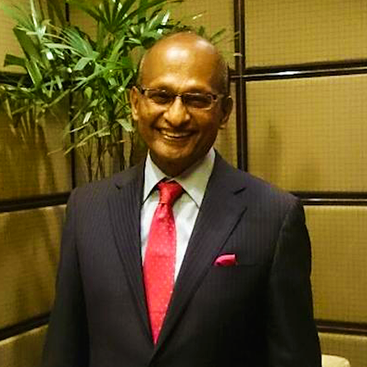
The following is Part 1 of a three-part series on how Maha Sinnathamby went from Sydney taxi driver to Australia's 49th richest person.
There is something special about the City of Springfield east of Brisbane.
When the land was purchased, it represented the single largest parcel of development land available in Australia at the time.
And when the developer decided to build a privately funded master-planned city on it rather than break it up and sell it off for a quick profit, there wasn't a privately owned project in Australia that compared to its scale and immensity.
People laughed at the developer – a Malaysian born Sri Lankan migrant and former taxi driver.
This wasn't a two or three year project we were talking about.
The scale of the project would likely take twenty, thirty, maybe even forty years to complete.
What's more, the developer didn't have the money to buy the land let alone develop it.
Yet today the City of Springfield continues to be one of the most dynamic urban growth areas in Queensland and home to some 28,000 residents and growing.
And the visionary developer building it – Maha Sinnathamby – is now listed by BRW Magazine as one of Australia's 49th richest person with an estimated worth of around $840 million.
So how did this Malaysian born Sri Lankan migrant and former taxi driver build a city with no money and become one of Australia's richest men?
And why would he even attempt such a project when most developers would simply break up the land into smaller parcels and sell it off for an easy profit?
To understand the answer, you first need to understand the man himself.
About Maha Sinnathamby
Maha Sinnathamby is not your average real estate developer.
He was born to poor Sri Lankan parents in Malaysia at the start of the second world war.
His family lived in a hut in a rural village built around a British-owned rubber plantation about 60 km south of Kuala Lumpur.
A few mats covered the dirt floor, water was collected from a well at the plantation and there was no electricity in the home.
His father Valipuram worked at the plantation seven days a week to put food on the table.
Valipuram was imprisoned for fourteen months by the Japanese during the second World War and upon his release, decided the only way to guarantee his young family's future was to educate his children.
Education was to be the family's salvation.
That decision eventually lead young Maha to Sydney where he studied engineering as a young man.
Study was particularly hard for Maha and he was forced to repeat the first two years of his degree.
His father Valipuram worked as hard as he could in Malaysia to support Maha during his studies. Maha drove taxis on the side to pay the rest.
Shortly after graduating, Maha moved to Perth to chase work as an engineer. Sadly WA's mining boom had just ended and there weren't any engineering jobs to speak of.
Penniless and unemployed, Maha put his engineering dreams on hold and eventually found work as a commission only real estate agent.
This of course introduced Maha to a new passion – property – which in turn lead to Maha pursuing a career as a property developer.
See Maha Live at Wealth Accelerator Summit 2015
Opossum Creek
Associated Forest Holdings (AFH) decided to sell their six Queensland plantations in 1990 after they had produced very little income in the previous year.
Initial interest was strong and all parcels of land sold except for one.
That one parcel was also their largest. Known as Opossum Creek, it sprawled 2860 hectares.
This parcel came with numerous economic problems.
For a start, it was a vast parcel of land – about 4.5 kms by 9 kms.
Yet there was only one regional road along the edge of the property and no water or other services to support development.
A huge investment in infrastructure was needed before it could become tenable for development.
A number of developers expressed interest in parcelling off the land and only purchasing the section closest to the road.
AFH knew however if they did this the rest of the land would be too isolated and virtually unsellable, so they decided to keep Opossum Springs packaged as a single parcel.
This scared off the big developers.
Maha's Fearless Principle # 1 – Make One Idea Your Life
A few years before Opossum Creek came onto the market, Maha and his business partner Bob Sharpless had gotten wind of a developer buying up land in Brisbane's Fortitude Valley and managed to secure one of the parcels of land they needed for the development.
The developer was livid and negotiated to swap it for three other sites and cash.When Maha and Bob decided to develop these sites, they hired a project manager called David Henry and it was he who introduced Maha to the idea of a master-planned city.
“Look around you”, David told Maha as they drove around one day looking for investment plots.
“It's a mess already. I tell you, go to the States. They've built whole communities where all the land is zoned en masse for planned development stretching years into the future.”
Ever since his father had introduced him to Ghandi as a young man, Maha had been searching a ‘big idea' to dedicate his life to.
Ghandi had done just that by dedicating his life to social justice and in particular, liberating India from British rule.
Maha had longed to do the same and finally found his calling when David introduced him to the idea of a master-planned city.
So when Maha saw Opossum Creek, he didn't just see a large empty dustbowl like other developers.
He saw the opportunity to dedicate his life around building an enormous master-planned city that had the potential to revolutionize property developing in Australia.
Buying Opossum Creek With No Money
There was just one problem however; Maha and his partner Bob didn't have any money.
While they had some assets, they also had similar debts and very little in the bank.
So they waited… Nine months passed and Opossum Creek still hadn't sold.
Now that developer after developer had turned their backs on it, Maha knew there was an opportunity for a deal.
He called the agent responsible for selling Opossum Creek and set up a meeting with the seller.
With no money in the bank, Maha knew that the only way he and his partner Bob could purchase Opossum Creek was with a property option.
A property option meant Maha and Bob could secure exclusive rights to purchase the land within a set period of time for an agreed purchase price. It gave them the right but not the obligation to purchase the land in the future during the term of the option.
The plan was to then seek development approvals to establish whether or not the project was viable.
If the approvals were successful, Maha and Bob could then exercise the option and purchase the land at the agreed price.
On the other hand if the approvals were denied, Maha and Bob could let the option expire and move on to the next project.
Maha and Bob had purchased properties this way in the past.
Sometimes they developed the property once the approvals came through. Other times they would on-sell the property with the development approvals and bank the profits.
Maha pitched the property option idea to the Opossum Creek seller.
He offered to pay the seller their full asking price of $7.84 million, but only if development approvals were successful.
If the approvals came through, they would then complete the sale but with the following payment terms; they would pay $3 million up-front and the remainder over 5 years.
He also agreed to a $300,000 option fee up-front as a sweetener.
The property option would expire in twelve months and the seller would bank the $300,000 regardless of whether the option was exercised or not.
With no other buyer in sight, the seller agreed.
Raising $3 Million To Complete The Sale
Bob and Maha had just achieved the impossible.
They had just secured the largest development land parcel available in Australia at that time with almost NO MONEY — using a property option and vendor finance to get the deal over the line.
But now they had to come up with the money.
So they hatched a plan.
The first step was to borrow the $300,000 required for the option from a friend, which they managed to do.
The second step was to apply for development approvals for the land and split the land into 12 separate titles.
Two of these titles were on the most viable section of land.
One was for 700 lots which Bob and Maha planned to keep and develop.
The other was a smaller title of around 400 lots which they planned to on-sell to another developer for the $3 million they needed to complete the sale.
While the second title was worth nowhere near the $3 million asking price in raw form, it could be if the developer approvals came through.
Development approvals were eventually secured.
The final step now was to find a buyer.
Maha activated his network of contacts and after making pitch after pitch was eventually introduced to a Taiwanese investor.
This investor was interested in purchasing the land through his company Cherish Enterprises and after much negotiations, agreed to its purchase for $2.84 million.
Maha had Cherish make the cheque out to AFH.
Maha and Bob then handed the cheque over to the Opossum Creek seller and came up with the rest themselves.
Not only had Maha and his partner somehow managed to control land they couldn't afford, they had sold land they didn't own and now owned the largest parcel of development available in Australia at that time with almost no money.
Lessons Learnt
The first lesson from Maha's story is focus.
Research suggests it takes 10,000 hours of deliberate practice before you can achieve excellence in a given area. If you are trying to achieve success in a number of different areas in your life and failing, then cut back your activities and solely focus your energies on just one or two areas.
The second lesson is leverage.
Can you really invest in real estate with no money? Absolutely, Maha is living proof. He bought Opossum Springs using nothing more than his knowledge on real estate and the art of the deal.
But buying Opossum Springs was just the beginning. Now that Maha and his partner Bob Sharpless owned the land, they had to figure out a way to develop it.
Canberra is the only other master-planned city in Australia comparable in scale to Springfield and that was developed by the Australian Government.
On the other hand, Springfield was privately owned and Maha and Bob didn't have the billions of dollars they needed to make Springfield a reality.
How did this savvy pair do it? Find out how in Part 2 of our series.


 ABOUT PAT MESITI
ABOUT PAT MESITI
Well Done Maha!…
That also took good knowledge of the processes and lots of guts to put it nicely.
Well done sir.
One needs a very close, trustworthy and focussed buddy with the same mindset. I completed a course on property development in Sydney a couple of years ago with the assurance that I will find someone to match my enthusiasm and motivation…but I guess it is all timing and one has to wait.